Jan 13, 2023
4 Great Examples of User-Generated Content (UGC)
User-generated content (also known as consumer-generated content) is a powerful way for marketers to raise brand awareness.
The beauty of UGC is that the content is created by someone else, an advocate, a customer, an employee, or a social media follower rather than the brand itself so carries more weight as word-of-mouth promotion.
Plus user-generated content is usually positive (although bear in mind opening the door to UGC means negativity can creep in) so you can leverage it to attract and influence new customers.
User-generated content is a great way to humanize your brand and show people the human side behind your product or service. It can make you more approachable as a brand, more likable, and ultimately more sellable.
So, let’s find out the nuts and bolts of UGC so you can use it to your best advantage.
What is UGC?
First of all, what is user-generated content? As the name suggests it's content created by someone else talking about your brand or related somehow to it.
So, the UGC content may or may not tag your brand, but a smart social media strategist keeps an eye out for content that could be useful, whether it's tagged or not.
According to Statista, 45 percent of shoppers conduct research online before making a purchase. This means that consumers seek out information or reviews on a product or service and feedback from real people can have more sway than brand-generated content.
The UGC content shared can be a video, image, testimonial, blog, live stream, review, or even a podcast.
This image-led example from Nike shows how the brand calls out for UGC to engage its online community. The brand regularly generates and reposts user content on their social accounts linked to hashtags like #AirMaxMondays.

Tip: Read our case study ‘Nike: Always Ahead of the Curve’ for an in-depth look at the marketing used by the mega-brand.
Why use UGC in your marketing?
The answer to why you should use user-generated content is simple. Because it works!
We all know the Covid-19 pandemic changed things. It made people reflect on how they live their lives, both in the way they work (work/life balance) but also in what and how they purchase.
Today’s customer wants to buy from brands that care about society and has an interest in the same issues e.g. sustainability. In fact, 82 percent of shoppers want a consumer brand’s values to align with their own while three-quarters will leave a brand over a conflict in values, according to research commissioned by Google Cloud.
Ultimately, UGC helps you connect with customers and followers in a way that’s meaningful and builds trust. It’s known as the modern word-of-mouth which we all know is very effective in marketing.
What’s the difference between UGC and influencer marketing?
Be careful not to confuse these two marketing tactics as they are very different in terms of the way you communicate and engage your audience.
While user-generated content is created by someone for no charge to promote or explain your brand, influencer marketing is sponsored content with a prior arrangement.
For example, you may have kicked off a campaign with an influencer or brand ambassador and have discussed what content to use, a posting schedule, captions, hashtags, etc. This could be a mega-influencer or celebrity like tennis player Naomi Osaka (below) or a micro-influencer that’s known and active in your industry.

Types of UGC content
There are many types of UGC content that a customer or fan may use to promote your brand or company which include:
- Social posts or sharing
- Customer reviews
- Case studies
- Referrals
- Community forums
- Webinars or podcasts
- Conferences
- Testimonials
Neil McKenzie, tourism marketer for Yarmouth & Acadian Shores told us how they find UGC content in a recent podcast. “Some of the content we want to make, we often have to push our operators to push good content and tell their patrons to tag the restaurants so we can pull that into their listings. And (content creators) see value in being featured on that content, and it helps local photographers and creators that are trying to get off the ground.”
Sources of UGC content
It’s important to think about what ‘user’ you are looking to highlight in your UGC content. Are you looking to showcase your company culture or how well you deal with customers?
Think about what you want to promote and who you want to reach out to when you call out for and share user-generated content. Here are three key groups to consider.
Customer-Generated Content
Customer-generated content is the most effective form of UGC.
The ‘Local Consumer Review Survey 2022’ found that 79 percent of customers put as much weight on online reviews as they would on personal recommendations.
No one takes blind chances on services or products anymore – consumers know how to do their homework, and they’ll make sure it’s done thoroughly.
Besides promoting personalized user reviewers who take social media platforms by storm with your brand name held high, when UGC is done correctly it will refer customers to you.
Here’s a great example of a tweet from @NikTheGeek endorsing the Amazfit smartwatch over its competitor Apple. He’s a regular guy and not a professional marketer or influencer - and that’s what makes this UGC.
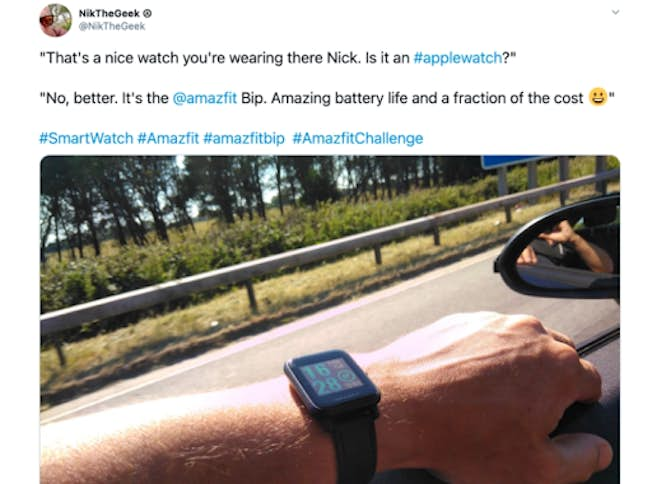
This word-of-mouth marketing strategy creates an added layer of authenticity, trustworthiness, and desirability among customers.
Employee-Generated Content
Brand messages are re-shared 24 times more frequently when distributed by employees than by the brand using its own channels, says Neal Schaffer.
While this is not the most effective user-generated content type, it definitely has its benefits – especially if you’re just starting out.
People will trust another person over a faceless company or crafted mission statement any day. If you don’t yet have a large following on social media or a group of people to choose a customer user from, consider encouraging and promoting employee-generated content first.
Here’s a great example from one of our own employees at DMI.
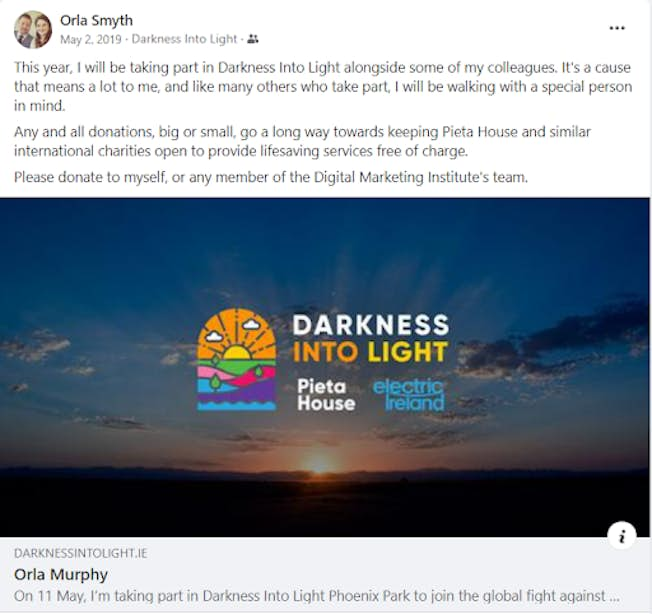
It’s a great way to show the human side of your brand and the people that work for you while introducing your brand’s culture and being authentic.
Brand Advocate Content
Having a brand advocate (that’s an individual and not an influencer) can be worth the extra work and planning it requires.
To find your brand advocate, narrow down your customer base to individuals who have interacted with your brand already, then ask them if they’d like to become a brand advocate. After that, let them take the lead.
For the full picture of how to find yourself the perfect brand advocate and leverage their abilities and connections, check out our ‘5 Tips for Effective Influencer Outreach’ or ‘5 Tactics To Get Great Customer Reviews’ blogs.
4 Brands Using UGC in a Stand-Out Way
Now that you know what user-generated content is (and is not) let’s look at some examples to draw inspiration from in your UGC campaigns.
While many brands use UGC tactics to create an authentic and powerful image, we’ve narrowed down the top four brands using user-generated content in the most unique and stand-out ways.
We will also offer tips on how you can implement these strategies for your own campaigns.
1. GoPro: Real-life Action
An obvious choice for this list is the technology company and sports camera maker GoPro. The reason? GoPro’s products naturally create UGC – just by being what they are.
As a popular action camera retailer, GoPro provides the platform and tools required to help customers share the images and videos they capture with their GoPro devices.
GoPro users generate roughly 6,000 GoPro videos online every day. Plus ‘GoProing’ is now a noun (and Twitter hashtag) used to describe the phenomenon while the brand’s tagline is ‘Be a Hero’.
Look at this fab example of UGC from 5-year-old budding skater Autumn, and her mum.
The company encourages users or customers to post content by:
- Asking users to use a #GoPro hashtag so their social media team can pick it up and choose which videos to post on GoPro’s platforms
- Uploading their favorite customer-generated content on their social or online channels
- Forming partnerships with tourist attractions and then providing cameras to visitors during their stay and encouraging them to share their adventures
- Integrating social sharing into the camera so all people need to do is take a picture, edit, and hit ‘share’
- Hosting competitions and events like the GoPro Million Dollar Challenge and the GoPro Awards
- Don’t have a UGC-specific product or service? You can still take a page from GoPro’s bible.
“I think our slow, humble beginnings in surf shops, ski shops, bike shops, and motorcycle shops have been extremely important for our success. GoPro is all about celebrating an active lifestyle and sharing that with other people. It’s authentic. It’s not a brand that we went out and bought a bunch of ads for to create” says Nick Woodman, Founder & CEO of GoPro
Tips to apply from GoPro
- Understand what your product or service does best and establish a ‘feeling’ that can be tied to your brand
- Brainstorm how to best display these actions and culture on social media
- Invite your audience to join in and become involved by using your product or service to be featured and a recognized part of your global community
- Consider incentives such as a challenge or competition to drive engagement
- Partner with people or brands that hold the same values and can co-promote
2. Calvin Klein: Hashtag-led engagement
Calvin Klein is an established brand but as it operates in such a competitive industry - the fashion world - it can be hard to stand out.
Cue the #mycalvins campaign, a hashtag-led phenomenon for the brand that sees over 870,000 posts on Instagram. Customers and fans post images of themselves in Calvin Klein underwear.
This example was shared by Hailey Heaton and re-shared on Calvin Klein’s account. When asked why she posted the image Hailey said “#mycalvins symbolizes openness and a comforting approach to underwear that makes everyone feel good in their own bodies. I’m all about body positivity, so I wanted to share parts of the body that are under-represented or normally retouched on the mass market.”
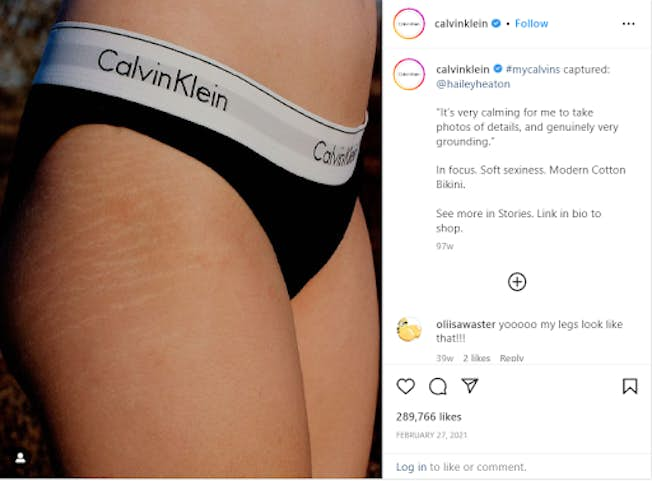
The message the campaign has embodied and grown as a result? Calvin Klein garments are for everyone and not just a sub-section of society.
Another hashtag for Pride has also taken off on the back of #mycalvins which is #proud mycalvins. It’s another avenue for UGC which sees Calvin Klein work with the LGBTQIA+ community to help express their moments of Pride.
Tips to apply from Calvin Klein’s campaign
- Take time to create a custom hashtag for your campaign. It will help you to find UGC content but also boost the possibility of trending.
- Kick off the campaign with your own content using the hashtag so it gains traction
- Share and reshare UGC posts using the hashtag
- Look at who is posting and what the content is. Could you reach out to relevant communities or audience members?
- Take learning from the UGC content shared and see if it can feed into your communication or other campaigns
3. Yosemite Conservancy: Harnessing Photography
These days, a stunning photo wins, every time.

Photographs are one of the best ways to encourage others to visit where you are, and given the natural beauty of Yosemite National Park in the US, these photos are very easy to capture.
Yosemite Conservancy’s ‘Yosemite Moments: Winter’ campaign encouraged people to submit their proudest park photos in the less-obvious winter season. Note this competition last ran in 2019 due to the Covid pandemic.
The winner of the ‘competition’ receives a year-long pass to the park along with park gear, while Yosemite Conservancy struck UGC gold – a ton of free, gorgeous photos that spreads national park lust and inspiration among social media users (and potential visitors) around the world.
If your brand or business doesn't revolve around a specific location, don’t worry.
Tips to apply from Yosemite Conservancy
- Brainstorm with your team about what makes your brand special. What makes you stand out? (Let’s say it’s community engagement or maybe even your office dog!)
- Strategize how you can translate these qualities into photos.
- Look up a local, professional photographer who specializes in brand photography. Run some of your ideas by them and see if they can add to your vision.
- Post your favorite professional photos on social media with your brand message for a couple of weeks to gain attention.
- Launch a giveaway, asking your followers to post a photo that also represents what you’re emulating through your photos while tagging your company in each photo they post.
4. Buffer - It’s about the user, not the brand
For the social media scheduling tool Buffer, the UGC content they inspire and share has often nothing to do with their product! Instead, it’s about the people that use it.
Using the hashtag #BufferCommunity, customers and followers share images of all types from gorgeous locations to pets to collages. So it’s not about using the tool but about the lives or pursuits of people that use it.
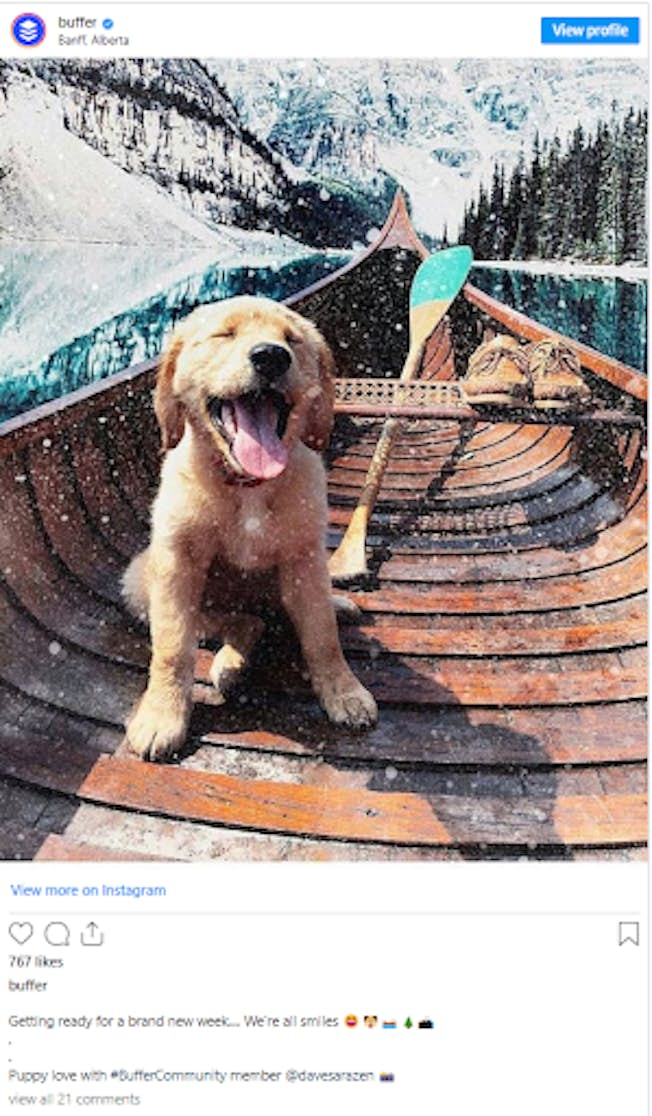
This type of UGC promotes Buffer in a way that shows the company to be versatile, fun, and easy to use without bigging up the brand in a way that makes it unauthentic.
Tips to apply from Buffer’s UGC campaign
- Your UGC campaign doesn’t need to be focused on what your brand does, it’s more about a feeling
- Just because you have a niche product or service doesn’t limit your engagement with users
- Cultivate your brand’s personality on social media to encourage people to share their lives with you
- Prompt people to share content and tell you more about them. Build a community.
UGC Campaign Round-up
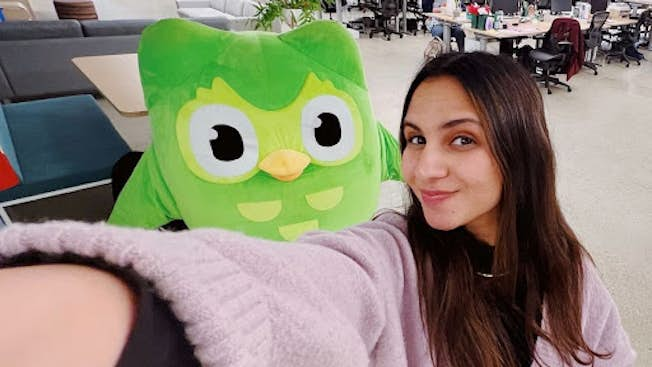
As you can see from the above examples, there are many sectors that can take advantage of UGC content.
The key is to tap into how people are using or feel about the brand and encourage them to share content that expresses it.
So, be creative and reach out to all areas of your business for ideas. You never know where a great idea will come from. Just look at the popularity of Duolingo’s owl mascot (brought to life by Zaria Parvez bringing in 5.5 million followers on TikTok alone!
Updated 2023
Use social media to promote your UGC campaigns
Social media is an effective channel to promote user-generated content. DMI’s social media marketing course will cover key UGC platforms like TikTok and Instagram along with social content, social apps, social customer service, and social strategy. Sign up today to get social savvy.
Related
Upgrade to Power Membership to continue
your access to thousands of articles, toolkits, podcasts, lessons and much much more.
Become a Power Member- Login
- View Courses
- - - -
- Courses
- Resources
- - - -
- My Account
- Change Password
- Logout





